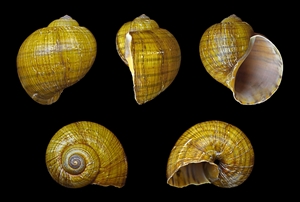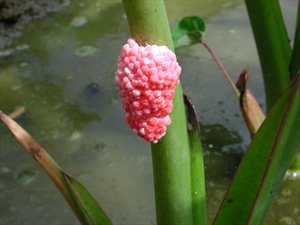- Widespread. Asia, Africa (Egypt, South Africa), North and South America, the Caribbean (Dominican Republic), Europe (Spain), Oceania. In Papua New Guinea. Not in Australia (interception), nor Palau (eradicated).
- Serious invasive pest. Generalist on rice, taro, lotus, kangkong, wild species, and more. Responsible for yield loss, replanting costs, pesticide use, phytoplankton blooms, biodiversity decline (native snails and natural aquatic vegetation), human disease (harbours rat lung worm).
- Adults, shells thin, yellow brown, greenish-brown, dark brown, 35-60 mm high, coiling to right, with brown horny opening. Has gills and a lung. Female lays pink eggs above water on plants and rocks. Young hatch and fall into water.
- Spread floating in water, crawling. Over large distances by aquarium trade, purposely as human food, exchange of planting material. Survival by hibernation in soil for up to 6 months.
- Biosecurity: listed by IUCN among 100 of World's Worst Invasive Species. National legislation and awareness needed to prevent its introduction and/or further spread.
- Cultural control: plough land and harrow; transplant at 3-4 weeks when plants less palatable; periodically lower irrigation water to stop snails moving and feeding; hand collect; attract snails to lay eggs on stakes, then remove and destroy; weed; allow ducks (Indian runners) into fields when seedlings 3-4 weeks; burn straw and stubble after harvest; rotate with legumes.
- Chemical control: note, metaldehyde NOT recommended: toxic to livestock, pets and humans; use baits with iron phosphate, sodium ferric EDTA - effective and safer.







